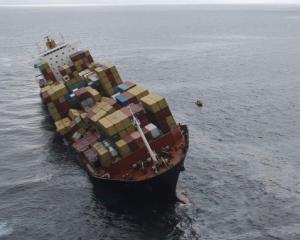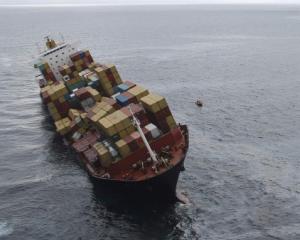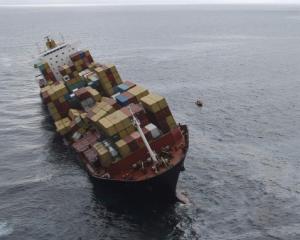A salvage expert says salvors face a nightmare as they try to recover not only the hundreds of containers still trapped in the submerged stern hold of Rena but the ship itself, when it inevitably sinks.
The ship's stern finally began its descent about 9.30am yesterday, leaving tonnes of timber and debris that littered Matakana Island and Waihi Beach and dozens of containers, one of which was spotted at Whiritoa, about 10km south of Whangamata.
The stern, which still has about 400 containers in its hold, is in a precarious position on the reef and was last night about 75% submerged.
Rena also leaked more oil, which was to have hit Motiti Island last night and today has Maketu and Matata in its sights, although Environment Minister Nick Smith said the slick was less than a fraction of the 300 tonnes that smeared Papamoa Beach in October.
Mr Smith said yesterday Rena was "in its death throes" and the Government's priority was now about minimising the environmental damage as it sank and broke up.
Questions turned to how the salvage operation, now an underwater one, would proceed, but Paul van't Hof, of Svitzer Salvage, was evasive.
"That's something we can only decide after doing our inspections. At the moment we would be guessing," he said.
Asked if the process involved raising the ship, he said: "at the moment we can't say anything".
But New Zealand Diving and Salvage general manager Howard Saunders said by law Rena would have to be removed when it sinks the 80m to 90m to the seabed.
"The sort of default position is wrecks have to be removed by the owners ... Unless they are alleviated from that requirement they will now have to mount a sub-sea floor operation, which involves cutting the vessel up into pieces and being able to lift it up on to barges to bring it ashore somewhere," Mr Saunders said.
Removing containers from Rena above water had been dangerous enough, he said.
"And under the sea it's going to be even worse," he said.
"If they are subject to any current or it's not stable on the bottom and it's moving around, the whole operation becomes a bit of a nightmare for them really."
Because the salvors would be likely working in depths of greater than 30m, they would have to use a sophisticated saturation diving spread - rarely seen in New Zealand - with underwater chambers and diving bells that allow divers to live and work safely at depth for days and even weeks, he said.
The underwater salvage job would be among the biggest projects in New Zealand's maritime history and possibly among the most expensive. Some saturation dive teams charge $US150,000 ($NZ189,000) a day.
"I think the Wahine took more than 12 months [to salvage], but that was done fairly slowly and the water depth was nowhere near as deep as what it is here."
Maritime New Zealand's national on-scene commander Alex Van Wijngaarden said oil spill response teams were ready and had placed booms in sensitive areas, while the oiled wildlife centre in Tauranga and volunteer programme had been reactivated.
Container recovery company Braemar Howells spokeswoman Claudine Sharp said the company had identified 49 containers yesterday, of which about 25 had beached at either Matakana Island or Waihi Beach.
She said that the company had deployed 13 vessels between Waihi Beach and Motiti Island to try to catch the drifting containers and attach them to a specialised barge.
Transport Minister Gerry Brownlee yesterday praised clean-up efforts of volunteers at Waihi Beach, saying they "have tolerantly put up with all the inconvenience that comes from these types of events".
Asked what the Government's position was on the wreck, he said it "will have to be removed".
- James Ihaka




